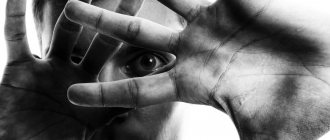Learn more about your problem by phone
If you are interested in more detailed information on the problem, leave your contact phone number, and the specialist on duty will call you back shortly and answer any questions.
I have read the Personal Data Privacy Policy and agree to the processing of personal data
Fear of “serious illness” is common:
- mental
- oncological
- cardiological
- or some other, unclear but frightening
Fear is accompanied by an obsessive search for signs of this disease.
Long-term anxiety can lead to panic attacks. Often, panic attacks and anxiety coexist with a fear of open or, conversely, too cramped space. There may be a fear of being in an awkward position in crowded places, for example: fainting, committing a senseless act.
Types of Anxiety Disorders
There are a huge number of varieties of this type of disease. The cluster of anxiety states includes obsessive-compulsive and panic attacks, phobic neuroses (Agarophobia, social phobia), post-traumatic stress disorder, hypochondriacal, personality disorder and many others.
Based on the duration of the affective episode, anxiety states are also divided into long-term and short-term . This aspect takes into account the period of time during which a person is unable to adequately respond to what is happening. Let's look at the most common forms:
Generalized anxiety disorder
It is a classic variation of neurosis and represents a type of chaotic anxiety, that is, without any logical direction. It is formed spontaneously and in response to everything, or more precisely, to events that attract the patient’s attention. The sick mind in this case is itself concentrated on finding and solving problems that actually do not exist (work, health, future, relationships). Such a person lives, in principle, with the question “What if?”, and overcoming one far-fetched problem, he comes up with the next one. Anxiety is localized primarily in thoughts (“mental chewing gum”), which is also characteristic of obsessive-compulsive disorder. Mostly the symptoms appear at night and prevent you from falling asleep deeply and for a long time.
At the everyday level, a person avoids everything new: for example, he walks the same road, flies to the same hotel (if he decides to fly in general). It seems to the patient that anxiety provides him with security, allowing him to be on alert, and he cannot be “caught by surprise.” Positive information and good events are leveled out and devalued by an anxious person. They are not happy with gifts and compliments.
Anxiety-hypochondriacal disorder
The main focus and experiences of the patient lie in the plane of his health. A person has constant anxiety regarding signals from his body, which he interprets as deadly. Hypochondria is also accompanied by a tendency to absorb specific and essentially unnecessary information. Most often, this type is combined with conversion and depressive pathologies.
Mixed and anxiety-depressive disorder
This type got its name due to a combination of symptoms defined as the “triad of depressive syndrome,” which includes: low mood, low motor activity and inhibition of mental processes combined with a high level of anxiety. Moreover, in a mixed form, increased anxiety in a patient may prevail over depression, or may correspond. The Hospital Anxiety and Depression Scale is used to assess the prevailing syndrome. The main psycho-emotional symptom, in addition to anxiety, is a lack of interest in life and loved ones, accompanied by vegetative pathology.
Paroxysmal anxiety (anxiety-vegetative) disorder
Paroxysmal, in fact, is another name for anxiety-panic disorder, or in simple words panic attacks, which we discussed in detail earlier. A panic attack is an acute attack of fear accompanied by mental and physiological symptoms.
Typically manifests itself with the following symptoms:
At the physiological level: increased blood pressure, shortness of breath, increased temperature, convulsions, palpitations, hyperhidrosis, tremors of the limbs, nausea and dizziness, insomnia. At the mental level, a person experiences a terrifying feeling of deconcentration and depersonalization (as if everything that is happening is unreal).
The intensity of a panic attack ranges from mild (anxiety and tension in the body) to severe (fear of imminent death). In general, it lasts from 15 to 30 minutes and can occur from 3 times a day to 1 time a month.
Anxiety-asthenic disorder
Another name for it is “anancastic” state of anxiety. Figuratively speaking, psychopathy manifests itself in a patient in the absence of order. As soon as the usual order of things is disrupted, or something new appears in the patient’s life, he falls into a feeling of uncontrollable anxiety. Those suffering from anancastic neurosis have a persistent desire to show perfectionism. In addition to the general characteristic symptoms, it is worth noting increased fatigue in the aspect of asthenic anxiety.
Organic anxiety disorder
Most often it appears against the background of somatic diseases, in connection with this, in patients, in addition to anxiety, dysfunctions of the body of various pathogenesis are observed in parallel (migraines, amnesia, deconcentration, disturbances in the functioning of the heart, thyroid or pancreas, liver).
Phobic disorders
This cluster is quite diverse and includes various types of phobias.
A phobia is an exaggerated, often unreasonable fear of some phenomenon, situation, object, which is often not so dangerous. The most common are social phobia (fear of any contact with people) and agoraphobia (fear of crowded places and open spaces). Phobias also include fear of snakes, spiders, airplane flights, heights, independent travel, and long-distance travel.
Formulations of diagnoses that you may encounter when visiting a doctor
If you have already consulted a doctor or are just planning to do so, then do not be alarmed if you are suddenly given one of the following diagnoses:
- VSD (vegetative-vascular dystonia), NCD (neurocirculatory dystonia)
- neurosis, neurasthenia
- hypochondria, hysteria
- panic neurosis, panic disorder
- post-traumatic stress disorder
- psychasthenia
- generalized anxiety disorder, anxiety neurosis, anxiety-depressive disorder
- astheno-neurotic syndrome, vegetative paroxysms,
- obsessive-compulsive disorder
Unfortunately, many people are accustomed to the fact that an endless state of anxiety is a normal phenomenon, and sometimes they don’t even remember what it’s like to be healthy and live in a good mood.
An anxious state always signals a more global problem - you are not satisfied with your life, and it’s time to do something.
If you have been experiencing emotional discomfort for a long time or have been diagnosed with one of the above, then this treatment and rehabilitation program is for you.
Anxiety-depressive disorder symptoms
- The clinical manifestations of this disorder combine symptoms of anxiety disorders and symptoms of depressive disorders.
- In addition, symptoms of autonomic nervous system overactivity, such as gastrointestinal discomfort, are common. This is why patients often seek medical help first.
DSM - criteria for mixed anxiety-depressive disorder
- The Diagnostic and Statistical Manual of Mental Disorders (DSM) puts forward a number of criteria for diagnosing this disorder. However, as we already mentioned, this is for research purposes only.
- An essential characteristic of this disorder is persistent or recurrent dysphoria (decreased mood) that lasts for at least 1 month. This condition is accompanied by additional symptoms of the same duration, including at least four of the following:
- Difficulty concentrating or memory, sleep disturbances, fatigue or lack of energy.
- Acute irritability.
- Permanent and intense anxiety.
- Increased tearfulness or feelings of hopelessness, pessimism about the future, worthlessness and low self-esteem.
- Increased vigilance, anticipation of danger.
These symptoms cause significant clinical discomfort or impairment in social, work, or other important activities.
- On the other hand, mixed anxiety-depressive disorder should not be diagnosed when symptoms are due to direct physiological effects of certain substances or other medical conditions. Or if the person has at any time been diagnosed with major depressive disorder, persistent depressive disorder, anxiety disorder, or generalized anxiety disorder.
- This diagnosis is also inappropriate if criteria for any other anxiety or mood disorder are simultaneously met, even if they are in partial remission.
- It is also necessary that the spectrum of symptoms cannot be consistent with another mental disorder. Much of the primary information about this disorder comes from primary care centers, where the disorder is more common and likely also has a higher prevalence among outpatients.
Clinical picture (how the disease manifests itself)
Main symptoms include:
- sudden onset of palpitations,
- asthma attack,
- nausea,
- chest pain,
- feeling of unreality (depersonalization and derealization).
- symptom of “cotton legs” - severe weakness in the legs,
- tinnitus, dizziness, darkening of the eyes,
- sensation of hot flashes inside the body.
All this happens against the backdrop of fear of dying, losing control or going crazy. After a panic attack, the patient feels weak and very tired, which is described as a “feeling of soreness.” Between attacks, anxiety persists, the fear that the attack will happen again. After repeated attacks, frightening thoughts appear about the “infinity” of the disease: “it will never end.” Sometimes panic attacks develop against the background of depression.
When do you need to use a course treatment program?
You are recommended to undergo the “Not Scary at All” treatment and rehabilitation program if you discover the following symptoms.
- Irritability, fear or anxiety, quickly developing into panic.
- Expectation of trouble or misfortune. Nervous tension. Physical stress. Headache.
- Intestinal dysfunction, diarrhea. Nausea and vomiting. Muscle pain.
- Decreased performance. Insomnia. Sexual disorders.
- Tachycardia (rapid heartbeat), shortness of breath (rapid breathing, lack of air).
- Fear of going crazy or losing control of yourself. A feeling of unreality of the surrounding world, a feeling of time slowing down.
- Fear of “disappearing.” Prostration. Decreased vitality and motivation for life, the perception of the environment is “flat”, “in gray colors”.
- With severe panic disorder, there is a fear that another panic attack will occur spontaneously, “in public.”
The main symptoms of anxious depression are:
- a feeling of anxiety that has no specific cause and almost does not leave the patient during the day;
- increased anxiety, tearfulness, irritability, inadequate alarm reaction to any unplanned events,
- low mood, feeling of hopelessness, constant expectation of something bad, internal tension, inability to relax;
- difficulty concentrating and maintaining attention (difficulty concentrating), memory deterioration, decreased performance;
- insomnia, fatigue, weakness, feeling of being on the verge of a breakdown.
In addition to mental symptoms, anxious depression has a lot of physical manifestations: trembling, palpitations, dizziness, pain in various parts of the body, sensations of heart failure, lack of air, difficulty breathing, tightness in the chest, “coma” in the throat, frequent urge to urinate, diarrhea , sexual dysfunction.
Often, patients begin to treat anxious depression on their own, resorting to taking over-the-counter medications available to them (phenibut, afobazole, glycine, Sonmil, Corvalol). At first, taking these medications brings some relief from anxiety symptoms, but the improvement is short-term and requires an increase in the doses of medications taken.
The next common step in self-medication for anxiety depression is daily intake of sleeping pills in increasing dosages (zopiclone, Somnol, Sonnex, Sonnat) or daily drinking of alcohol to relieve tension and alleviate anxiety symptoms. This kind of “treatment” leads to further disturbances in the metabolism of GABA and dopamine, aggravates the course of the disease, and leads to the formation of dependence on alcohol or sleeping pills. An attempt to stop taking alcohol or sleeping pills causes severe anxiety, which the sick person is unable to resist.
Important! Anxious depression requires long-term specialized treatment and does not go away on its own!
Treatment of anxiety and depressive disorders in Neurology
Don’t tolerate illness – seek specialized help!
Anxiety and depressive disorders require immediate medical attention due to the high risk of chronicity of the disease. It is not uncommon for acute attacks of fear to continue to torment for years. Fortunately, panic attacks are well treated with modern methods. Neurology statistics show that when completing the course program, significant improvement occurs in the vast majority of cases.
Every day, specialists at the Neuro-PSI clinic analyze world practice in the field of psychiatry and psychotherapy. The goal is the impartial selection and implementation of those methods of treatment and psychological assistance, the effectiveness of which has been convincingly proven in independent studies.
We are guided only by the principles of evidence-based medicine.
Causes of anxiety-depressive disorder
Four lines of research suggest that symptoms of anxiety and depression are associated with the following identified causes.
1. First, several researchers have found similar neuroendocrine causes of depressive and anxiety disorders. They include:
- cortisol response to adrenocorticotropic hormone
- growth hormone response to clonidine
- thyroid-stimulating hormone
- prolactin response to thyrotropin-releasing hormone
2. Second, a number of researchers have presented data that identify hyperactivity of the noradrenergic system as a significant factor in the occurrence of depressive and anxiety disorders in some patients
Specifically, these studies have shown that patients with depressive or anxiety disorders who are actively experiencing an anxiety crisis have high concentrations of the norepinephrine metabolite MHPG in their urine, plasma, or cerebrospinal fluid.
As with other anxiety-depressive disorders, serotonin and GABA may also be involved in the origin of mixed anxiety-depressive disorder.
3. Third, many studies have shown that serotonergic drugs such as fluoxetine and clomipramine are useful in the treatment of both depressive and anxiety disorders.
4. Finally, several family studies have provided evidence suggesting that anxiety and depressive symptoms are genetically transmitted, at least in some families.
What is the essence of the treatment program for anxiety-phobic disorder?
Any mental disorder greatly affects the quality of life and keeps you in constant tension, so our task is to quickly relieve you of panic attacks and chronic anxiety, teach you self-control skills and return you to a full life.
Clinic specialists (psychologists, psychotherapists, psychiatrists) carry out comprehensive work with the client, taking into account the main factors that create well-being. The main emphasis is on teaching the client the correct reaction to his thoughts, emotions, internal sensations and interpretation of external events.
What treatment methods are used?
Primary: cognitive behavioral psychotherapy. (the gold standard for the treatment of panic and anxiety disorders throughout the civilized world)
Besides:
- stress exposure,
- breathing techniques training,
- training in progressive muscle relaxation techniques,
- therapy using a biofeedback system,
- self-control training,
- modernization of lifestyle,
- resolving family conflicts,
- assistance in self-realization and establishing relationships,
- specific drug therapy (for severe disease).
Why are these particular methods used?
If you have tried other methods before, then you know that hospitalization, massage, exercise therapy and acupuncture bring only temporary relief, since they do not affect the mental sphere, on which the condition of the entire body depends.
Prevention of anxiety-depressive disorder
As with many illnesses, anxiety and depression should be prevented. To do this, you need to learn the basics of self-regulation, prevent or try to reduce the impact of stress on your body. Here are general common tips for preventing any psychological problems, including anxiety-depressive disorder:
- Balanced diet.
- Physical activity.
- Compliance with work and rest schedules.
- Quitting bad habits (smoking, alcohol abuse, drug addiction).
- Good dream
- Using relaxation techniques. Mental hygiene
- Working with a psychologist: it is important to get rid of negative thinking patterns and stress in a timely manner
All of these tips will also be useful in the process of treating an already diagnosed anxiety disorder. It is very important to follow the recommendations of your doctor. It must be remembered that the effect of anti-stress and antidepressant therapy can be observed gradually, over 2-3 weeks. At the same time, a healthy lifestyle will help you prevent the disease or cope with it faster if it has already occurred, as well as prevent relapses in the future.
Very important
your active participation in treatment. Remember, the success of treatment depends only on you and your attitude towards your own health. Be healthy!
The information presented in this material is for informational purposes only and does not replace professional advice from a physician. If you notice signs of depression, consult a specialist!
Author: Editorial staff of the Help-Point.net portal
Start working with a psychologist right now
Start a consultation
Tags: consultation with a psychologist depression help psychologist online seasonal depression Beck's test for depression online test anxiety level
Share
Comments
- Comments
Loading comments...
Previous article
Causes of schizophrenia
Next article
How does the treatment program work?
Each treatment program at the NEUROPSI consists of four stages:
- diagnostics
- working with symptoms of the disease
- working with the causes of the disease
- consolidation of achieved results
Work efficiency is increased by accurately planning the time required to achieve therapy results. This means that each program is adapted to the problem that the client has addressed.
The program method of treatment is predictable, time-limited, productive, and most importantly, understandable to the client.
Of course, treatment takes place in a comfortable manner without interruption from work, study or family. Specialists of various profiles will work with you (team method). This is necessary to minimize the risk of diagnostic errors that could lead to the adoption of a suboptimal treatment plan.
Improvements in well-being and mood (healing) occur in stages: following a decrease in emotional problems, physical symptoms decrease. Working with the causes of anxiety and phobias allows you to avoid relapses in the future.
What are the results and prognosis?
Upon successful completion of the program, you will get rid of unmotivated fears, panic attacks and multiple vegetative symptoms (sudden surges in blood pressure, rapid heartbeat, dizziness, nausea)
According to statistics, the effectiveness of the methods used is close to 100% if all recommendations of specialists are followed.
Skills you acquire during the program:
- self-control and self-regulation
- constructive analysis of the body's condition
- understanding your own mental and emotional sphere
- ability to act consciously in stressful situations
The emotional and physical state improves significantly, and confidence in oneself and the future is gained. Emotional stress is relieved, sleep and appetite are restored. Performance increases many times over.










